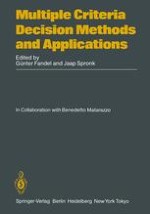Both the 'First International Summer School on Multiple Criteria Decision Making Methods, Applications and Software' and the present volume of readings could only be realised with assistance and support from many sides. We would like to express our gratitude to all those who have contributed to making a success of the first of a hopefully long series of summer schools in this field and to all those who have contribut. ed to the present volume. First of all we are grateful for the financial means supplied by a long list of sponsors, the most important of which are mentioned on the copyright page. Next, we are grateful to the members of the organising committee, Anna Ostanello and Giovanni Zambruno. Since this is the first of what will become a series of summer schools, the chairman of the organising committee, Benedetto Matarazzo, will start this volume with a brief account of the school held in Acireale. The programme committee consisted of Jean Fichefet, Anna Ostanello, Bernard Roy, Jaap Spronk (chairman) and Stanley Zionts. Their valuable contribu tion is gratefully acknowledged, as is the contribution of all the lecturers at the school. Of course, a school is not only made by its teachers, but just as much by its students. The primary aim of a school is to teach and to stimulate the students.
